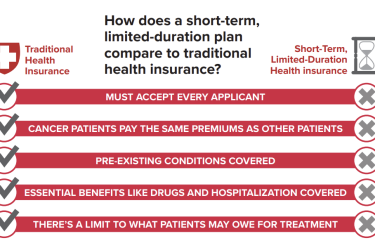 Remember when Sen. Susan Collins, Maine’s moderate Republican, predicated her vote for the Senate tax bill that included the repeal of the individual mandate on Majority Leader Mitch McConnell’s promise to her that the Senate would vote on two ACA stabilization measures?
Remember when Sen. Susan Collins, Maine’s moderate Republican, predicated her vote for the Senate tax bill that included the repeal of the individual mandate on Majority Leader Mitch McConnell’s promise to her that the Senate would vote on two ACA stabilization measures?
Those bills did not make it into short-term spending bill at the end of 2017, nor the last month’s short-term spending bill. We aren’t holding our breath that they will be in the next bill, or the one after that. To recap:
One of the bills was a bipartisan plan from Sens. Lamar Alexander and Patty Murray (respectively the chairman and top Democrat on the Senate HELP Committee). It aimed to restore the cost-sharing subsidies that President Trump terminated last fall.
But that bill – never a sure thing in the Senate and a harder fight in the House – was drafted a few months ago, before repeal of the mandate. Alexander and Murray both have said it needs to be renegotiated given the changes to the ACA since their original bipartisan agreement, but they have not released any details yet. It’s not clear to me how deep into the new negotiations they are.
The second part was the reinsurance bill from Collins and Florida Sen. Bill Nelson. No action there yet either. Neither of these are necessarily dead forever but they are dormant at the moment. Part of this is because Congress is preoccupied with the larger spending bill and of course immigration and DACA. But it is also because the GOP has not quite decided how to proceed on the ACA this year, in the months leading up to midterm elections in which health care again will play a role.
HHS also has been rudderless for a few months, but with Alex Azar now confirmed as the new Health and Human Services secretary, some policies may become clearer.
The Collins-Nelson bill sits on the back burner on the Hill, and related waiver activity at CMS also has halted. Alaska’s proposal was approved, and part of Minnesota’s was OK’d. But Oklahoma withdrew its waiver because CMS did not approve it in time. Alison Kodjak of NPR offers a good explanation of the rise and fall of that waiver approach to reinsurance.
We wrote recently about how backers of one form of “invisible risk pools” have perhaps oversold how well they worked in Maine, but that does not mean that many policy experts do not think these pools are still an idea worth considering. They can spread risks more widely than in traditional high-risk pools, so the sickest people are not getting priced out of insurance.
In our last post on invisible pools, we referenced a Health Affairs post that discussed how the Maine program had fallen short (or shorter than some champions claimed). A subsequent Health Affairs post, “Correcting Misconceptions About Invisible Risk-Sharing,” by Josh Archambault and colleagues, drew on a Milliman analysis to make the case that properly designed, the invisible pools could restrain premiums and protect people with pre-existing conditions. They possibly may even entice more people to get covered in what the authors argue would be a better functioning individual market








